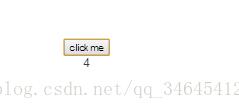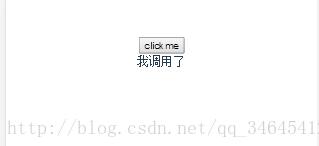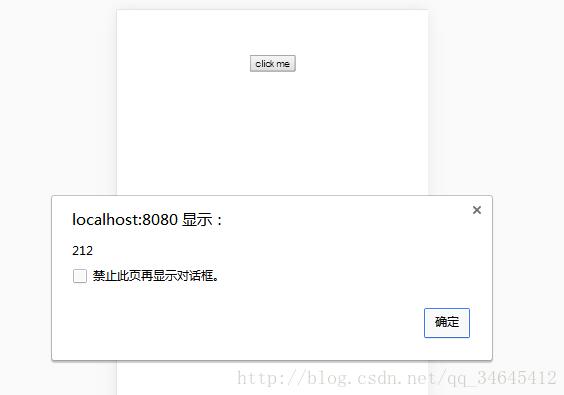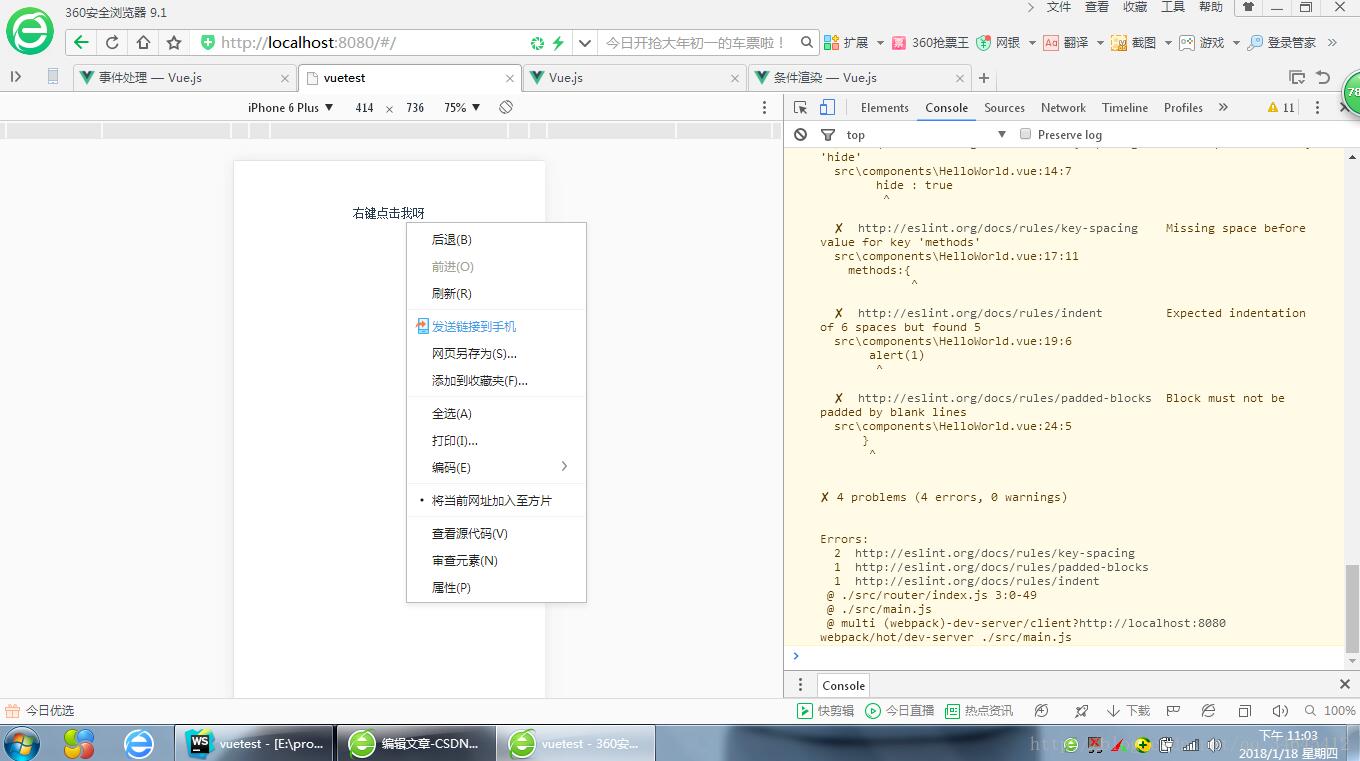vue 实现click同时传入事件对象和自定义参数
HTML
<div id='app'> <button @click='tm(123)'>ddddd</button></div>
JS代码
new Vue({ el:’#app’, methods:{ tm:function(e){ console.log(e); } }})仅仅传入事件对象
HTML
<div id='app'> <button @click='tm'>ddddd</button></div>
JS代码
new Vue({ el:’#app’, methods:{ tm:function(e){ console.log(e); } }})同时传入事件对象和自定义参数
HTML
<div id='app'> <button @click='tm($event,123)'>ddddd</button></div>
JS代码
new Vue({ el:’#app’, methods:{ tm:function(e,value){ console.log(e); console.log(value); } }})
补充:vue常用事件之v-on:click 以及事件对象,事件冒泡,事件默认行为
其实v-on后面跟的不止是click事件也可以是其他的事件,用法均相似。比如:v-on:click/mouseout/mouseover/mousedown.......
以下click为例
注意:所有的v-on都可以简写为@,比如说v-click可以简写为@click
1.监听事件可以用 v-on 指令监听 DOM 事件,并在触发时运行一些 JavaScript 代码。通常来讲就是监听dom触发一些操作,这些操作(比如点击)触发后执行的动作(js)可有直接写在后面
v-on:click='item+=1'
eg:
<template> <div > <input type='button' value='clickme' v-on:click='item+=1'/> <div>{{item}}</div> </div></template> <script>export default { name: ’HelloWorld’, data () { return { item:1 } }}</script> <!-- Add 'scoped' attribute to limit CSS to this component only --><style scoped> </style>
结果:

可以看见每点击一次绑定的值就增加1.也就是说可以吧js的操作放在事件触发的后面。但是有时候逻辑太复杂的时候写在里面就会造成混乱,视图和逻辑混淆。所以click后面可以接一个方法,把所有处理逻辑的方法封装在一个函数里面click的时候调用
2.事件处理方法v-on:click='greet'
eg:
<template> <div > <input type='button' value='clickme' v-on:click='greet'/> <div>{{res}}</div> </div></template> <script>export default { name: ’HelloWorld’, data () { return { name : 1, res:'' } }, methods:{ greet: function () { // `this` 在方法里指向当前 Vue 实例 this.res=’Hello ’ + this.name + ’!’; } }}</script> <!-- Add 'scoped' attribute to limit CSS to this component only --><style scoped> </style>
效果:

可以看见点击之后执行了greet方法里面js逻辑
3.带参数的时间绑定方法:同上,唯一区别是携带了参数
v-on:click='greet(name)'
<template> <div > <input type='button' value='clickme' v-on:click='greet(name)'/> <div>{{res}}</div> </div></template> <script>export default { name: ’HelloWorld’, data () { return { name : 1, res:'' } }, methods:{ greet: function (reccept) { // `this` 在方法里指向当前 Vue 实例 this.res=’Hello ’ + reccept+1 + ’!’; } }}</script> <!-- Add 'scoped' attribute to limit CSS to this component only --><style scoped> </style>
效果一致。对方法的调用同样可以一个方法多处多次的调用
4.内联处理器中的方法也就是说在方法里面调用其他的方法,这里的其他方法可以是js原生的方法比如阻止冒泡呀等等,也可以是自定义的方法
v-on:click='greet(name,$event)'
eg:
<template> <div > <input type='button' value='clickme' v-on:click='greet(name,$event)'/> <div>{{res}}</div> </div></template> <script>export default { name: ’HelloWorld’, data () { return { name : 1, res:'' } }, methods:{ greet: function (reccept,event) { if (reccept===1) this.say() }, say:function () { this.res='我调用了' } }}</script> <!-- Add 'scoped' attribute to limit CSS to this component only --><style scoped> </style>
效果:

$event 拿到当前点击事件的事件对象,比如click就是拿到当前点击的dom事件对象信息
v-on:click='greet($event)'
eg:
<template> <div > <input type='button' value='clickme' v-on:click='greet($event)'/> </div></template> <script>export default { name: ’HelloWorld’, data () { return { hide : true } }, methods:{ greet: function (ev) { alert(ev.clientX) } }}</script> <!-- Add 'scoped' attribute to limit CSS to this component only --><style scoped> </style>
效果:

当不阻止事件冒泡的时候会弹两次
eg
<template> <div > <div @click='show1($event)'> <div @click='show2($event)'>点击我呀</div> </div> </div></template> <script>export default { name: ’HelloWorld’, data () { return { hide : true } }, methods:{ show1: function (ev) { alert(1) }, show2: function (ev1) { alert(2) } }}</script> <!-- Add 'scoped' attribute to limit CSS to this component only --><style scoped> </style>
那么但阻止冒泡后就只会弹一次
eg:原生js阻止冒泡
ev1.cancelBubble=true
<template> <div > <div @click='show1($event)'> <div @click='show2($event)'>点击我呀</div> </div> </div></template> <script>export default { name: ’HelloWorld’, data () { return { hide : true } }, methods:{ show1: function (ev) { alert(1) }, show2: function (ev1) { ev1.cancelBubble=true alert(2) } }}</script> <!-- Add 'scoped' attribute to limit CSS to this component only --><style scoped> </style>
那么vue自己封装的阻止冒泡方法呢?
@click.stop='show2()'
eg:
<template> <div > <div @click='show1()'> <div @click.stop='show2()'>点击我呀</div> </div> </div></template> <script>export default { name: ’HelloWorld’, data () { return { hide : true } }, methods:{ show1: function () { alert(1) }, show2: function (ev1) { alert(2) } }}</script> <!-- Add 'scoped' attribute to limit CSS to this component only --><style scoped> </style>7.阻止默认行为:
比如:如下右键之后会将默认的菜单带出来
<template> <div > <div> <div @contextmenu='show2()'>右键点击我呀</div> </div> </div></template> <script>export default { name: ’HelloWorld’, data () { return { hide : true } }, methods:{ show2: function (ev1) { alert(2) } }}</script> <!-- Add 'scoped' attribute to limit CSS to this component only --><style scoped> </style>
效果:

那么就有了阻止默认行为
ev1.preventDefault();
eg:
<template> <div > <div> <div @contextmenu='show2($event)'>右键点击我呀</div> </div> </div></template> <script>export default { name: ’HelloWorld’, data () { return { hide : true } }, methods:{ show2: function (ev1) { alert(2); ev1.preventDefault(); } }}</script> <!-- Add 'scoped' attribute to limit CSS to this component only --><style scoped> </style>
点击后默认菜单将不会显示(PS早360浏览器右键无效)
vue里面的封装的阻止默认行为的方法:
@contextmenu.prevent='show2()'
eg:
<template> <div > <div> <div @contextmenu.prevent='show2()'>右键点击我呀</div> </div> </div></template> <script>export default { name: ’HelloWorld’, data () { return { hide : true } }, methods:{ show2: function (ev1) { alert(2); } }}</script> <!-- Add 'scoped' attribute to limit CSS to this component only --><style scoped> </style>8.其他事件修饰符
用法都一样就不再赘述
.capture
.self
.once
<!-- 阻止单击事件继续传播 --><a v-on:click.stop='doThis'></a><!-- 提交事件不再重载页面 --><form v-on:submit.prevent='onSubmit'></form><!-- 修饰符可以串联 --><a v-on:click.stop.prevent='doThat'></a><!-- 只有修饰符 --><form v-on:submit.prevent></form><!-- 添加事件监听器时使用事件捕获模式 --><!-- 即元素自身触发的事件先在此处处理,然后才交由内部元素进行处理 --><div v-on:click.capture='doThis'>...</div><!-- 只当在 event.target 是当前元素自身时触发处理函数 --><!-- 即事件不是从内部元素触发的 --><div v-on:click.self='doThat'>...</div>
使用修饰符时,顺序很重要;相应的代码会以同样的顺序产生。因此,用 @click.prevent.self 会阻止 所有的点击 ,而 @click.self.prevent 只会阻止对元素自身的点击。
2.1.4 新增
<!-- 点击事件将只会触发一次 --><a v-on:click.once='doThis'></a>
不像其它只能对原生的 DOM 事件起作用的修饰符,.once 修饰符还能被用到自定义的组件事件上。如果你还没有阅读关于组件的文档,现在大可不必担心。
<!-- the scroll event will not cancel the default scroll behavior --><div v-on:scroll.passive='onScroll'>...</div>
Vue 为这些修饰符额外提供了 .passive 修饰符来提升移动端的性能。
举个例子,在滚动的时候,浏览器会在整个事件处理完毕之后再触发滚动,因为浏览器并不知道这个事件是否在其处理函数中被调用了 event.preventDefault()。.passive 修饰符用来进一步告诉浏览器这个事件的默认行为不会被取消。
不要把 .passive 和 .prevent 一起使用。被动处理函数无法阻止默认的事件行为。
以上为个人经验,希望能给大家一个参考,也希望大家多多支持好吧啦网。如有错误或未考虑完全的地方,望不吝赐教。
相关文章:
1. vue-drag-chart 拖动/缩放图表组件的实例代码2. vue使用moment如何将时间戳转为标准日期时间格式3. Android studio 解决logcat无过滤工具栏的操作4. 什么是Python变量作用域5. js select支持手动输入功能实现代码6. PHP正则表达式函数preg_replace用法实例分析7. Android Studio3.6.+ 插件搜索不到终极解决方案(图文详解)8. bootstrap select2 动态从后台Ajax动态获取数据的代码9. Android 实现彻底退出自己APP 并杀掉所有相关的进程10. 一个 2 年 Android 开发者的 18 条忠告

 网公网安备
网公网安备